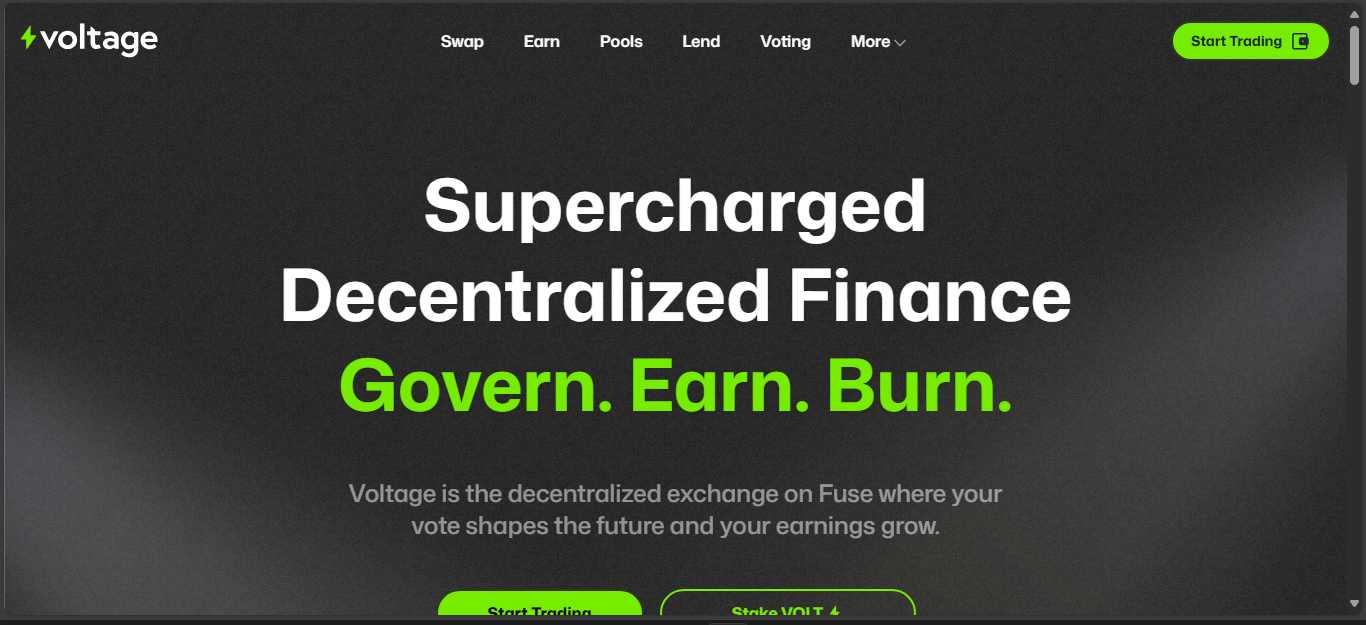Voltage Finance – Exchange Review

Snapshot
Voltage Finance (FuseFi) is a DeFi protocol on Fuse Network, combining swaps, yield farming, lending, staking, stablecoin, perps and cross-chain bridges. It uses the VOLT token for governance and rewards. TVL sits at around $707K, while token trading volume fluctuates between $160K-220K daily.
First Impressions
The user interface is intuitive – plug in a wallet and access swaps, liquidity pools, staking, lending and perps. No account or KYC required. It presents as a full-stack DeFi platform blending features found on both AMMs and lending platforms.
Core Features
Multi-Module DeFi
Voltage offers swaps, yield vaults, lending, staking on ETH or USDC, perps, cross-chain bridges and stablecoin issuance. It aims to serve as a one-stop DeFi destination.
Audited Smart Contracts
Audits by QuillHash cover staking modules, stableswap forks, fUSD bridge and Liquid staking (sFuse). Findings include reward logic fixes and stronger flash-loan protections.
Liquid Staking and fUSD
Users can deposit ETH or USDC to earn yields and receive sFuse or fUSD in return – options not common on Fuse chain but popular in other ecosystems.
Volume, TVL and Token Metrics
- TVL: ~$707K across staking, vaults and liquidity pools
- Token price and volume: VOLT trades around $0.000086, with ~220K USD volume daily
- Token supply: Max 10B, Circulating ~4 B, FDV ~$792K
The protocol handles modest liquidity – enough for small to mid-size DeFi use, but too limited for high-value or institutional flows.
Security and Risks
Past Exploits
- March 2022 exploit: A reentrancy vulnerability drained ~$4.7M, linked to misuse of ERC677 tokens
- March 2025 incident: ~$322K withdrawn from staking pools via compromised proxy contracts
- Hacker activity: Stolen ETH (~$182K) was later mixed through Tornado Cash
These incidents show the protocol is battle-tested but still susceptible to vulnerabilities.
Audits and Mitigations
QuillHash audits in 2022 addressed key weaknesses – correcting reward logic and strengthening against flash-loan attacks. While comprehensive, most audits were done 1-2 years ago – updates may be needed post-2025 exploits.
Decentralization
No custodial risk exists – users retain their keys. Smart contracts are largely immutable, and the protocol has a guarantee fund and collateral safeguards.
Pros and Cons
Pros:
- Rich DeFi feature set on Fuse – swaps, perps, staking, lending, stablecoin issuance
- Audited smart contracts with mitigations applied
- Non-custodial and permissionless access
- Community-driven governance via VOLT token
Cons:
- Modest TVL and trading volume limit scalability
- History of exploits and ongoing smart contract risks
- Audits age-dated – need reassessment post incidents
- No fiat bridge or fiat on-ramp
- Interface lacks mobile app or dedicated support channels
Ideal Users
DeFi enthusiasts comfortable with smart contracts who want a multi-product platform on Fuse. It suits experimental trades, yield strategies or small perps bets. Not for institutional capital, high-stakes lending or anyone looking for audited, enterprise-level safety.
Final Word
Voltage Finance is an ambitious, feature-packed DeFi suite on Fuse – audited, innovative, and non-custodial. Yet its history of hacks and modest liquidity make it risky. Treat it like a powerful DeFi lab rather than a polished financial platform. Use small amounts, monitor governance updates, and wait for refreshed audits. For DeFi builders and yield chasers, Voltage offers a lot – just navigate with care.
Disclaimer
“This content is for informational purposes only and does not constitute financial advice. Please do your own research before investing.”






